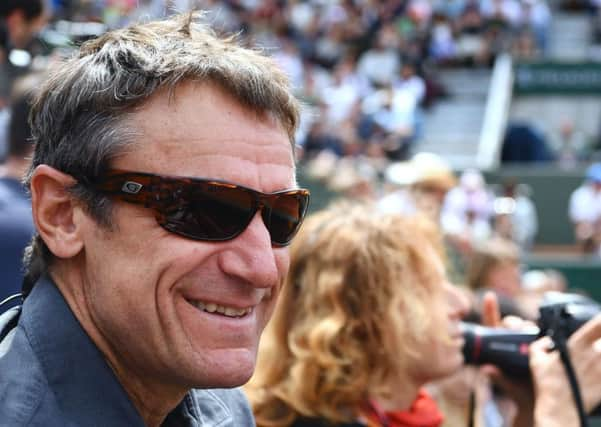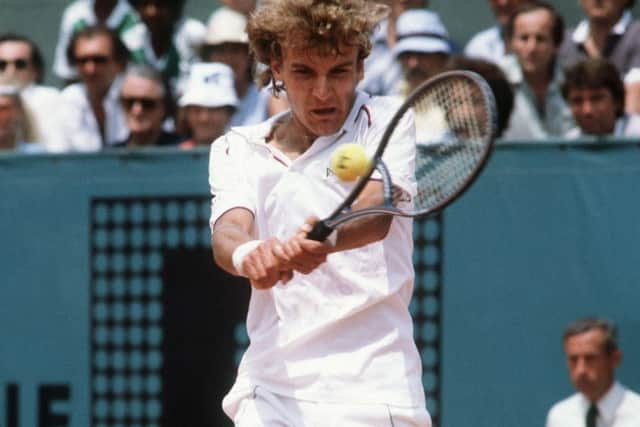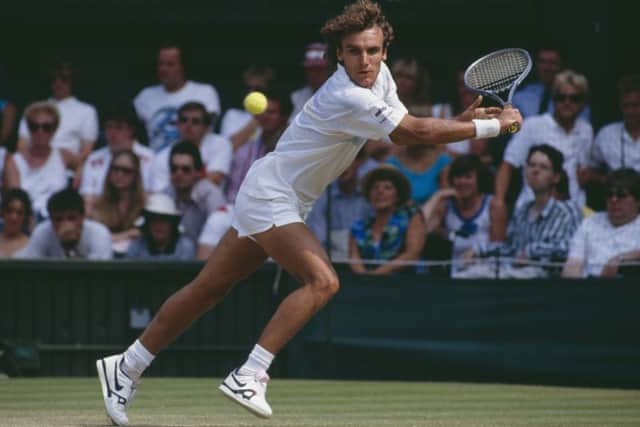Interview: Mats Wilander on grand slams and rock songs


This might have helped get him a better press. The first report I can find mentioning him that year comes from the Australian Open. “Possibly the world’s most conservative player,” it says, before going on to describe his deliveries as “pedestrian”, so much so that spectators were queueing to leave, and concluding that his opening-round victory had been “tedious and uninspiring”.
In another sense, though: ya boo sucks. Who needs warm reviews when you’ve seized the trophy, which Wilander did after what he admits was a “lucky” victory over the local hero, Pat Cash?
Advertisement
Hide AdAdvertisement
Hide AdNext stop, Paris, but still the write-ups were decidedly un-rave. “Dull Mats” went one headline. “Horribly boring to watch … a terrible uncharismatic tennis star.” But before we forget: he won the French in ’88 as well.


Next up Wimbledon, which Wilander didn’t win, the prize going to his fellow Swede, juniors rival and another member of the ball-juggling foursome, Stefan Edberg – and then it was on to Flushing Meadows for the US Open where our man overcame Ivan Lendl to become surely the most under-appreciated three-out-of-four guy there has ever been in grand slam tennis.
By then, Wilander was getting his retaliation in first. “I had a good joke for the press-room,” the man who’s now Eurosport’s expert eyes on the game tells me. “If a Swedish tennis player and a Czech tennis player were dropped off the top of the Empire State Building at the same time, which one would hit the ground first?
“My answer was: ‘Who cares?’ When Ivan and I played, on any surface at any time, people were not that interested in either of us. I think we both couldn’t have been any less bothered about that but in tennis in the 1980s there was Jimmy Connors and there was John McEnroe, both very original in game style and behaviour and more entertaining for sure, and crowds wanted to see them rather than two guys who seemed to have been made in a factory.”
We’re talking in the lead-up to Wimbledon and if Wilander, now 52, ever really was a baselining Borgite robot, clanking off a production line on the outskirts of Stockholm with a double-fisted backhand set to stun, then very soon he was nothing like that at all.


This is a man who’s dabbled in poetry. “It was more just thoughts that were put down on paper,” he says. “I wrote in airports and on planes. I was a teenager. I was young and inexperienced but also unafraid.” Still, I don’t think Pete Sampras ever scribbled verse.
Wilander has more than dabbled in rock music, going as far as releasing an album with a friend, Christopher Seldon, and touring his homeland –and unfortunately our half-hour together isn’t nearly long enough to explore his deep love for Bob Dylan. Suffice to say, though, that when I ask him for his favourite Dylan tracks he chooses Neighbourhood Bully and the equally unobvious Buckets of Rain.
“As someone who’s travelled seven months of every year since he was 15, I admire Dylan for his Never-ending Tour. Sure I’ve seen him perform loads of times and always he’s been great. He can be a grumpy old man and he can f*** up and I probably like these shows the best. I don’t expect him to entertain the crowd but to sing and play from the heart.”
Advertisement
Hide AdAdvertisement
Hide AdFrom the heart. It’s one of Wilander’s favourite phrases. “I’m interested in life” is another. If he sounds like a hippie that’s probably because he is. For three months of every year, he leaves behind his wife – South African-born ex-model Sonya – and four kids in their Idaho home and chugs round America in his travelling tennis roadshow. At nights the “Wilander on Wheels” RV gets parked in campgrounds and round the fire he might whip out his acoustic guitar.


“I love the freedom of the road,” he says. “I like to camp and to not have to check in to airports and hotels and I love to just drive, man. Do you know that’s how I saw Scotland for the first time? Two years ago straight after Wimbledon I hired a motorhome for a golfing holiday. My golf is one day good, the next shit. But in beautiful Scotland who cares?”
And this is a man who not only quotes Dylan but John Cleese as well. “His show [Fawlty Towers] is the one I’ve watched more than any other.” Me too, and I’d love to discuss with a fellow obsessive how the gags always came in threes (“What did you expect to see out of a Torquay hotel window … Sydney Opera House? The Hanging Gardens of Babylon? Herds of wildebeest sweeping majestically … ?”) but we really should talk tennis.
I’m interested in speaking to Wilander because the Swede at the conclusion of his stupendous 1988 and Andy Murray at the end of last year seemed to chime. Both climbed to the summit of the men’s game, No 1 in the world, but the sheer effort of getting there appeared to shatter them. In Wilander’s case he would tumble down the mountain to No 41 within two years, complaining that he’d lost his edge and tennis was no longer fun.
“Our stories are slightly different,” he says. “Andy was much older than me when he got to No 1 and I’d already won six majors, the seventh doing it for me, but in my case I’d never been driven or motivated to be the No 1. The fun was still there a bit at the start of the following year but what wasn’t fun was always having to try and beat the guy on the other side of the net and keep doing that always.


“When you’ve won as much as Andy has and I did then at some point you have this thought and want to shout across that net: ‘Man, I’m ranked No 1 in the world and have won three or seven majors and I do not want to have to fight this match so hard because you should not even have a chance to beat me so why don’t you just understand that I’m better than you?!’”
The view from tennis’ toppermost peak is splendid but if you were hoping for stillness and serenity, forget it. Can you stay up there? Do you even want to? Playing the world’s best – in Wilander’s case, Lendl, Edberg and Cash and not forgetting Boris Becker – he could “get the feeling back” but lower-ranked opponents would present problems. “These fellas didn’t have much fear – or respect! For Andy – and Novak Djokovic, too – the challenge at Wimbledon will be to show up every day when the only thing that matters will be needing to live in the present, play the match and win it.”
Can Murray win the tournament again? “If what you just asked me enters his mind then he’s not going to win that’s for sure. The fact he’s had the rank of No 1 for the past six months is completely irrelevant. He got that by being the most consistent player in 2016 and all credit to him. But he’s not the best player in the world right at this moment. He might be in the top six, seven or eight but the fact he has ‘1’ next to his name means nothing.
Advertisement
Hide AdAdvertisement
Hide Ad“He needs to go and play every point, every game as if he’s in the final. He needs to get back to the state of needing to win tennis matches. Right now he’s not there yet. I saw glimpses of the great Andy Murray at Roland Garros. The semi-final [in which he was beaten by Stan Wawrinka] was a great match but in a funny way it was his easiest of the tournament. Maybe going out first round at Queen’s didn’t look so good on paper but it could still work out okay given he will have had nearly two weeks to not worry about winning matches and work on his game. I know that in the past he’s won Wimbledon when he’s won Queen’s in the build-up but, you know, life changes.”
Life changes. That’s another phrase Wilander uses often. You’ll have noted the trouble that fearless and disrespectful opponents caused him. If he really was such a Borg-bot then wouldn’t it have been well within his capabilities to simply obliterate them? Automatons aren’t normally possessed of the individualistic thinking to one day yank at their internal wiring and spark a short-circuit and contemplation of rock-star dreams.
Hailing from the southern Swedish industrial town of Vaxjo and the youngest of three brothers, Wilander started playing tennis at six on the parking lot of his father’s factory, the old man painting court lines on the asphalt and fashioning a net from chicken wire. His mother, by the way, had a job on the assembly-line of another factory, although this wasn’t engaged in the production of mechanical tennis prodigies.
Equally as talented at ice hockey, Wilander decided to concentrate on tennis just as Sweden wondered if Bjorn Borg, the iceman of 11 major triumphs, was going to be a glorious one-off in the country’s sporting history. Indeed in 1982 when Borg, who was in dispute with the tennis authorities, boycotted the French Open after lifting the title the previous four years, hardly any Swedish newspapers bothered to send journalists to Paris.
What chance an unseeded 17-year-old? Lendl, Vitas Gerulaitis and Jose Luis Clerc probably fancied they could win in Borg’s absence, but Wilander beat them all. He was fearless but not disrespectful, famously refusing to accept a match point against Clerc, saying: “His ball was good. I cannot win this way.” Today he puts the gesture down to youthful naivete. “After a few years on the tour you realise nobody’s going to do that for you.”
In the final against Guillermo Vilas he insists his ambition was simply to win one game and not be embarrassed. “Then I noticed Vilas was changing his socks and I thought: ‘Wow.’ Then he was arguing with his coach and I thought: ‘Something’s happening.’” It was. The youngest-ever male grand slam winner was about to be crowned.
Inevitably Wilander’s success saw him hailed as the heir apparent to the Golden Headband. “I’m not Borg Two, I’m Wilander One,” he declared, immediately hacking off his long locks. The master, holidaying on a Greek island, returned quickly to Sweden so he could watch his successor on TV.
Borg, says Wilander, was “the world’s hero” and for him easy to imitate. “It wasn’t so much the strokes but his behaviour on court, the good attitude, working hard. I played him just the once and of course that was daunting. It felt like a Rolling Stones concert, Keith Richards unwell, and this kid taking his place. Borg threw me a bone in each set, let me break his serve, so I was beaten 6-1, 6-1 rather than whitewashed.”
Advertisement
Hide AdAdvertisement
Hide AdWilander’s mental toughness and metronomic consistency, trapping his challengers beyond the baseline then, when they found a way out and forwards, flashing his trademark topspin lob, would bring him two more French titles and three Australian, but never Wimbledon. “The grass courts in my day were much faster, especially with Wimbledon coming right after the French where the clay back then was really slow. I had no choice but to serve and volley which I could do physically but I wasn’t able to play smart tennis, tennis I felt in my heart.”
It was just before Wimbledon in 1991 that Wilander decided: “F*** it, I want to play music.” Lyrics on his album, Ghost of Margareth, seemed to lay bare his angst of that period: “Wonder why I can’t stop screaming … my head is aching like an atom bomb.” He enjoyed the rock lifestyle but plays down his musical prowess. “I’m a useless guitar-player. When I put myself in a band I immediately became its weakest part. I was like my forehand volley at tennis.” Not even using that forehand anymore, his ranking plummeted to 330. After a two-year exile he retrieved his racquet but, beaten by opponents he’d have whipped in his prime and asked how that felt, was moved to reply: “Do you ever think about the girls you get at 18 compared to 45? Do you ever think you are about to die?” He retired from the tour for good in 1996.
Dull Mats? Not really, and sometimes his life has been far too dramatic. For instance, he could have been on the doomed Lockerbie jet. “I was injured and because I was too much of a woosy to have a cortisone injection straight through my shin I didn’t make the reservation.” In 1998 after Melbourne’s Queen Street Massacre it emerged that the killer had been a big Wilander fan. “Wow, I didn’t know that,” he says. Then there was that messy end to his career when he tested positive for cocaine. His appeal against his suspension was later withdrawn. Of that incident he will only say: “I contested the procedures. In those days they were very sloppy. Now they’re full-on professionally done.”
Wilander may have lost his motivation for tennis after reaching the top but he’s never stopped loving the sport. This is evident when he’s at the mic for Eurosport and behind the wheel of his 37ft charabanc, criss-crossing the States to coach, play exhibitions and generally enthuse. “You can play tennis when you’re three and 103. It really is the greatest game in the world,” he says. “Plus, when I’m in my RV, you never know what’s round the next turn in the road.”
l Eurosport is showing nightly highlights of Wimbledon at 10pm featuring analysis from Mats Wilander, Greg Rusedski and Annabel Croft and will also broadcast live coverage of the men’s and women’s finals.